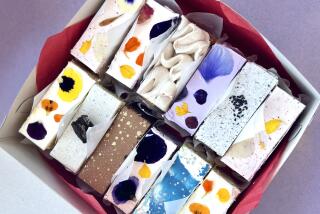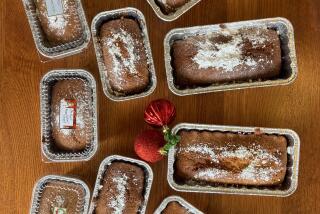IN THE KITCHEN : The Search for the Perfect Strawberry Shortcake
- Share via
Most fruits and vegetables come into season quietly, on cat’s feet. One day you look and there is asparagus. Or you’re out shopping and realize artichokes are finally coming down in price. You think, “Oh, how nice,” and pick up a couple.
The exception to this is strawberries. Strawberries come into season accompanied by waving flags and blaring brass bands.
Maybe that’s because strawberries are the best fruit Southern California has to offer--with the possible exception of citrus, which we take so much for granted it could be culinary wallpaper.
Yet nowadays, when you can find something called a strawberry in the market year-round, trucked in from Mexico, flown in from Chile . . . at this time of year it pays to stop at a farmers market or even one of the strawberry stands that still dot the area and pick up the real thing.
Bite into one of these strawberries and you’ll be amazed. These berries are soft, sweet and spicy--a far cry from the tasteless Styrofoam that passes for strawberries most of the year. (There are two things to check to get the best berries: You should be able to smell them as you approach the stand, and they should be of the Chandler variety, the king of California early-season berries.)
When you’ve got really perfect berries of the kind we’re getting now, you want to treat them as simply as possible. The first few boxes I picked up I simply sliced and sugared and ate with vanilla ice cream. (Again, a short checklist: Always rinse and dry the berries before topping them, and--unless it’s absolutely impossible--don’t stick them in the refrigerator. It kills the perfume.)
Then, as the newness wears off, you can move into more involved recipes. Right about now, I’m deeply into strawberry shortcake, traditionally the best American strawberry dessert. In fact, I’m so far into strawberry shortcake that I spent a couple of days trying recipe after recipe, searching for the ultimate version. Let me tell you, there are a lot of shortcakes out there.
First of all, let’s define what we’re talking about. Shortcakes are not the things you find for sale in most produce departments. They may call them shortcakes but they’re spongecakes, with an emphasis on sponge. They look more like a piece from an automobile shock absorber than a shortcake. Actually, I think what some people do is find a shuttered auto parts plant someplace in Michigan and convert it for the summer to making these little foam disks.
Real shortcakes are short. In baking terms, that means they crumble when you cut them with a fork, rather than being soft and pillowy. They’re actually sweetened biscuits, and most recipes for them are very similar--flour, butter, sugar, baking powder and whipping cream.
But when you get down to testing them, you find that within those five ingredients there’s a lot of room for variation.
For example, the shortcake in Janeen Sarlin’s “Food From an American Farm” (Simon & Schuster: 1991) has only 1/4 teaspoon sugar per cup of flour and no butter whatsover. It’s a Grant Wood kind of biscuit--monochromatic and severe as a Midwestern still-life.
Nancy Silverton’s, in “Desserts” (Harper & Row: 1986), is sweeter (2 1/2 teaspoons sugar per cup of flour) and is made with butter, but she also uses a little more baking powder than most. She also bakes the cakes at a lower temperature for a longer time than the others. It makes a brown, crumbly biscuit with a pronounced wheatiness from the longer baking and a bit of bitterness from the baking powder.
The shortcake in the 1975 edition of my “Joy of Cooking” (Bobbs-Merrill) was somewhere between those two--1 1/2 teaspoons sugar per cup of flour, but finished with milk rather than cream. It was good but--dare I say it?--not great.
Maida Heatter’s shortcake (“Great American Desserts,” Knopf: 1985) was something else entirely--two tablespoons of sugar per cup of flour and finished with milk mixed with an egg rather than cream. It was baked in two nine-inch cake pans and served all at once. Never mind, it was too sweet and too cakey.
The shortcake that came closest to the one I had in mind was Lindsey Shere’s in her “Chez Panisse Desserts” (Random House: 1985). (Why is it that everything I bake from this book turns out tasting almost exactly like what I have in mind?) Anyway, the Shere cake has the same amount of baking powder as Silverton’s but a little more sugar--one tablespoon per cup of flour. It’s a very small difference, but it moved the bitter-sweet balance in the right direction.
In fact, I added a bit more sugar, and that proved to be exactly right to my taste.
Finally, we have to talk about whipped cream--the crowning glory for any great shortcake. It should go without saying that only cream you’ve whipped yourself will do, but these days you can’t be too careful. It’s not hard, really. In fact, when I took a mess of shortcakes and strawberries to a friend’s house for dessert, they didn’t have a whisk to whip the cream, so I used a fork. It was a bit more strenuous, but ultimately it worked fine. Remember, don’t whip the cream too stiff--it should just hold soft mounds.
And don’t oversweeten it. These aren’t ordinary everyday biscuits or strawberries it’s topping, and you want to be able to taste the cream--save the sugar for the Styrofoam and shock absorber.
ULTIMATE STRAWBERRY SHORTCAKE
4 pints strawberries, rinsed and hulled
1/4 cup sugar
10 shortcakes
2 cups whipping cream, whipped
Cut strawberries in half and toss with sugar. Set aside 1/2 hour.
Split each Shortcake while still warm. Spoon plenty of strawberries over bottom of each shortcake, top with generous spoonful of whipped cream and set top half of Shortcake on top. Makes 10 servings.
Each serving contains about:
380 calories; 263 mg sodium; 82 mg cholesterol; 25 grams fat; 36 grams carbohydrates; 4 grams protein; 0.70 gram fiber.
*
It’s important that your baking powder be active for the recipe to work, as there is no other leavener. The first couple of times we tried it in The Times Test Kitchen, the biscuits looked more like cookies than cakes. A change of baking powder did the trick.
Shortcake
2 cups flour
1 tablespoon baking powder
3 tablespoons sugar
Dash salt
1/2 cup chilled butter, cut into 8 pieces
3/4 cup whipping cream
Sift flour, baking powder, sugar and salt into medium mixing bowl. Rubbing between fingers, or cutting with crossed knives or pastry cutter, work butter into dry ingredients until mixture forms consistency of cornmeal, with few larger lumps of butter left intact. Add half of cream and stir into dry ingredients with fork. Add remainder of cream, bit by bit, until mass forms that pulls cleanly away from bottom and sides of bowl. You may not use all of cream.
On lightly floured work space, quickly and lightly knead dough until smooth and cohesive. Gently roll out 1/2-inch thick. Cut out biscuits with 3-inch biscuit cutter, or lightly floured juice glass. Gather leftover dough together, knead again briefly and roll out again. Cut remaining biscuits.
Place biscuits on unbuttered baking sheet and bake at 400 degrees until light-brown and slightly crusty, about 10 to 15 minutes. Remove from oven and cool slightly before splitting and serving. Makes 10 biscuits.
More to Read
Eat your way across L.A.
Get our weekly Tasting Notes newsletter for reviews, news and more.
You may occasionally receive promotional content from the Los Angeles Times.











